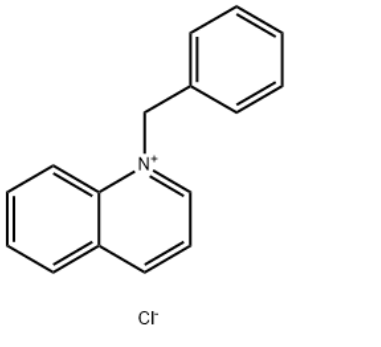
IdentificationPhysical DataSpectraRoute of Synthesis (ROS)Safety and HazardsOther Data
Identification
Product Name1-Benzylquinolinium chlorideIUPAC Name1-benzylquinolin-1-ium;chloride Molecular StructureCAS Registry Number 15619-48-4EINECS Number239-695-2MDL NumberMFCD03939541Beilstein Registry NumberSynonyms1-Benzylquinolinium chloride15619-48-41-benzylquinolin-1-ium chlorideBenzylquinolinium chlorideN-Benzylquinolinium chlorideQuinolinium, 1-(phenylmethyl)-, chlorideQuinolinium, 1-(phenylmethyl)-, chloride (1:1)1-(Benzyl)quinolinium chloride1-benzylquinolin-1-ium;chlorideQuinolinium, 1-benzyl-, chlorideQuinoline-N-benzyl chloride quaternaryAI3-51333DTXSID8044593NSC-1903761-benzylquinolin-1-ium,chlorideEINECS 239-695-2NSC 1903761-benzylquinoliniumchloride1-benzylquinolin-1-iumchlorideSCHEMBL1071121CHEMBL3184319DTXCID60245939P729Y93KATox21_302628NSC190376AKOS016373521SB70509NCGC00256768-01LS-14470CAS-15619-48-4FT-0607413W-1104131-Benzylquinolinium chloride15619-48-41-benzylquinolin-1-ium chlorideBenzylquinolinium chlorideN-Benzylquinolinium chlorideQuinolinium, 1-(phenylmethyl)-, chlorideQuinolinium, 1-(phenylmethyl)-, chloride (1:1)1-(Benzyl)quinolinium chloride1-benzylquinolin-1-ium;chlorideQuinolinium, 1-benzyl-, chlorideQuinoline-N-benzyl chloride quaternaryAI3-51333DTXSID8044593NSC-1903761-benzylquinolin-1-ium,chlorideEINECS 239-695-2NSC 1903761-benzylquinoliniumchloride1-benzylquinolin-1-iumchlorideSCHEMBL1071121CHEMBL3184319DTXCID60245939P729Y93KATox21_302628NSC190376AKOS016373521SB70509NCGC00256768-01LS-14470CAS-15619-48-4FT-0607413W-110413Molecular FormulaC16H14ClNMolecular Weight255.74InChIInChI=1S/C16H14N.ClH/c1-2-7-14(8-3-1)13-17-12-6-10-15-9-4-5-11-16(15)17;/h1-12H,13H2;1H/q+1;/p-1 InChI KeyGFEJZIULYONCQB-UHFFFAOYSA-M Canonical SMILESC1=CC=C(C=C1)C2=CC=CC3=CC=CC=C32.
Physical Data
AppearancePink and brown powder
Melting Point, °C Solvent (Melting Point) 17065H2O
Spectra
Description (NMR Spectroscopy)Nucleus (NMR Spectroscopy)Solvents (NMR Spectroscopy)Temperature (NMR Spectroscopy), °C Frequency (NMR Spectroscopy), MHzChemical shifts1Hwater-d2400Chemical shifts13Cchloroform-d1101
Route of Synthesis (ROS)
Route of Synthesis (ROS) of 1-benzylquinolinium-chloridecas-15619-48-4
ConditionsYieldWith sodium hydroxide In ethyl acetate at 80℃70 %Experimental Procedure General procedure: Halogenated quinolinium/pyridinium salts 1 (0.20 mmol, 1 equiv), sulfonyl azides 2 (0.24 mmol, 1.2 equiv), and NaOH (0.6 mmol, 3 equiv) were added to a 35-mL tube in EA (2 mL), and then the mixture was stirred at 80 °C for 7 h under air atmosphere. After complete conversion of the substrate (monitored by TLC), 20 mL of H2O was added, and the reaction mixture was extracted with EA (20 + 10 mL), washed with water (30 mL) and brine (30 mL), dried over Na2SO4 and concentrated under reduced pressure. Then the solution was filtered by flash chromatography (petroleum ether/ethyl acetate 10:1). The filtrate was evaporated by rotary evaporator, and the residue was purified by silica gel column chromatography to give the desired product 3.
Safety and Hazards
No data available
Other Data
TransportationUnder the room temperature;sealed.HS CodeStorageUnder the room temperature;sealed.Shelf Life1 yearMarket Price
DruglikenessLipinski rules componentMolecular Weight255.747logP5.807HBA0HBD0Matching Lipinski Rules3Veber rules componentPolar Surface Area (PSA)3.88Rotatable Bond (RotB)2Matching Veber Rules2
Quantitative Results1 of 3Comment (Pharmacological Data)Bioactivities presentReferenceThe Oxidation of 1-Alkyl(aryl)quinolinium Chlorides with Rabbit Liver Aldehyde Oxidase2 of 3Comment (Pharmacological Data)Bioactivities presentReferenceStructure of a novel Benzyl Quinolinium Chloride derivative and its effective corrosion inhibition in 15 wt.% hydrochloric acid3 of 3Comment (Pharmacological Data)physiological behaviour discussedReferenceIndolizine quaternary ammonium salt inhibitors, part III: Insights into the highly effective low-toxicity acid corrosion inhibitor-synthesis and protection performance
Use Pattern1-Benzylquinolinium chlorideCAS#:15619-48-4 is an intermediate.
https://www.chemwhat.com/1-benzylquinolinium-chloridecas%ef%bc%9a15619-48-4/
Comments
Post a Comment